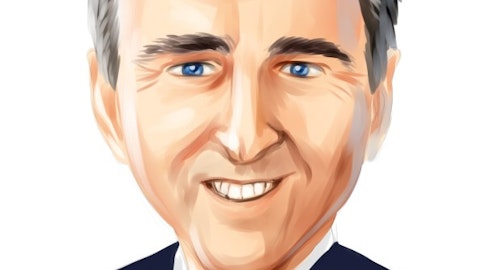Andrea Susan James – Dougherty & Co: Fantastic. Thank you so much.
Operator: Our next question comes from Adam Jonas with Morgan Stanley. Your line is open.
Adam Jonas – Morgan Stanley & Co: First question is to follow-up on…on the gigafactory, aaa…is…is the formal announcements aaa…formal announcements are kind of more…more than a letter of intent a pre request for breaking ground on the factory?
Elon Musk: Aaa…aaa…no we actually expect to break ground on the first gigafactory location, amm…or we want to…to [unclear] precise about this because I…I don’t want any of the states with which we are talking to…to sort of have the wrong impression. Amm, we gonna move forward with breaking grounds on multiple sites aaa…in order to minimize the risk of completion of…of the gigafactory. Amm, and aaa…we expect to break ground on the amm…on the first of those probably next month. Amm, so it should be quite soon amm…and then shortly thereafter maybe a month or two after that we’ll break ground on the second one.
Amm, and aaa…sure to say that California is potentially back in the running amm…so that’s – I…I mean it’s…it’s still…still in these sort of improbable, aaa…you know, you know a kind of a being improbable…but it is…it is back in running aaa…and the governor and his staff have…have really, I think, tried to do everything they can to aaa…make California a significant candidate for the gigafactory. Amm, the…the main thing with…with California is is [unclear] do it in centers or anything like that is…is the time to completion of the gigafactory.
Amm, I don’t think we did a good a job of explaining why California wasn’t on the list of four states aaa…to begin with and it’s…it’s just because this is a large aaa…Greenfield aaa…construction project. California has quite a complex aaa…and lengthy aaa…process for approval of Greenfield sights. And aaa…you know…so…so what we couldn’t afford was waiting like a year or more for kind of to…to proceed, amm…which would I think also make sure, you know, no environmental impact of any significance, aaa…but aaa…it would just take a long time for the California Regulatory Agencies to process information that they would need to aaa…for their obligations on the California Law. Whereas in other states it’s much more streamlined approach.
Amm, and if this was just the vehicles we build aaa…in Fremont, California, if we don’t…if we don’t have the gigafactory online when we have the aaa…vehicle capacity online, we will actually be in deep trouble, because we’ll have all the equipment and tooling, and people for making cars, but not…not be able to produce the battery packs. So aaa…that…that was the reason why California wasn’t originally on the list. The…the Governor and Legislature are gonna try to do something about that, but I think the question of timing is…is still a big one. Amm, and aaa…and then we also need to make sure that the ongoing operational costs of the gigafactory are not significant worse than other states. So I…I think like I said, I think California’s still in the sort of improbable, but…but not of impossible category at this point.
Adam Jonas – Morgan Stanley & Co.: Okay, thanks. Thanks Elon. Let me just add a follow-up. When you’re thinking about the gigafactory, is the idea to have just one dedicated full-cell supplier like a Panasonic, or is it possible that it could be Panasonic and…and a kinda some co-opetition with another battery component or cell supplier, kind of making another part of the…of the sub-cell, the cathode, or anode. Or it’s just kind of…is there mutual or pure exclusivity for a Panasonic, for example? And than finally, on China, do you have – or the expansion of other manufacturing in China or Europe, is that within the scope of your current capitalization and financial resources, or is that something – or that of your expectation of your ca…cash-flow generation, or is that another item on the list that might require aaa…new capital at some point? Thank you.
Elon Musk: Yes, so…so the way the Giga factory is set up right now is we aaa…Panasonic would be the only company producing cells in the gigafactory. Amm, and aaa…I want it…one other thing in gigafactory is like sort of like an industrial park under…under one roof. Amm, Tesla’s producing the modules – Te…Tesla is sort of the overall I guess landlord. We’re producing the modules and the battery pack. Then the aaa…the cells are…are pro…produced by Panasonic and then we would actually have a number of other companies producing the [unclear] to the…the anode catheter, separators, electrolytes and so forth that have been feeding into Panasonic.
However, if…amm…referring back to our [unclear] of short presentation on the…on the gigafactory, you’ll see that the cell capacity target is around thirty five gigawatt-hours, but the…the pack capacity is fifty. That’s…so we expect to bring in cells from aaa…other cell factories in the world to make up for others who are roughly fifteen gigawatt-hours, amm…and those would be – I would expect a lot of those would be Panasonic cells, but amm…to a degree that Panasonic isn’t able to meet that demand, there would be aaa…other suppliers as well.
Adam Jonas – Morgan Stanley & Co.: Okay.
Operator: Thank you. Thank you. Our next question comes from Patrick Archambault with Goldman Sachs. Your line is open.





